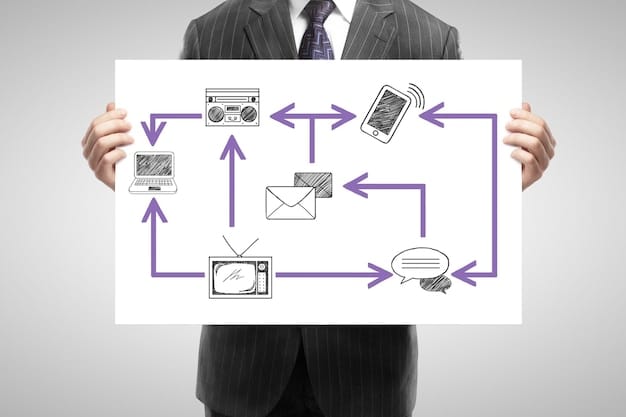Email Marketing Automation: Boost Leads & Sales in 2025

Email marketing automation in 2025 is about leveraging AI-powered tools and hyper-personalization to nurture leads, drive sales, and build lasting customer relationships through strategically automated email campaigns.
In 2025, email marketing automation is no longer just about sending automated emails. It’s about creating personalized customer journeys, leveraging AI to predict behavior, and delivering hyper-relevant content that converts leads into loyal customers and drives sales.
The Evolution of Email Marketing Automation
Email marketing has evolved significantly, from basic broadcast emails to sophisticated, automated campaigns. Understanding this evolution is crucial to appreciating the possibilities of email automation in 2025.
Early Stages of Email Marketing
Initially, email marketing involved sending mass emails to large lists. This approach was simple but lacked personalization and often resulted in low engagement rates.
The Rise of Automation
As technology advanced, automation tools emerged, allowing marketers to send targeted emails based on user behavior and demographics.
- Personalization became a key focus, with dynamic content and tailored messaging.
- Segmentation allowed marketers to group subscribers based on specific criteria.
- Behavioral triggers enabled automated responses to actions such as website visits or purchases.
Modern email marketing automation goes beyond simple triggers. It incorporates AI, predictive analytics, and machine learning to create highly personalized and effective campaigns. This includes dynamic content optimization, predictive segmentation, and AI-driven A/B testing.

The evolution of email marketing automation reflects a broader shift toward customer-centric marketing strategies. By understanding the history and current trends, businesses can better leverage email automation to nurture leads and drive sales in 2025.
Key Components of Email Marketing Automation in 2025
Effective email marketing automation in 2025 involves several key components that work together to create a seamless and personalized customer experience.
Segmentation and Targeting
Segmentation involves dividing your email list into smaller groups based on specific criteria such as demographics, purchase history, or engagement level.
Personalization
Personalization goes beyond using a subscriber’s name in an email. It involves tailoring the content, offers, and timing of emails to match individual preferences and behaviors.
- Dynamic content: Adjust email content based on subscriber data.
- Personalized subject lines: Increase open rates with tailored subject lines.
- Behavioral triggers: Send emails based on specific actions subscribers take.
AI-driven personalization takes email marketing automation to the next level. AI algorithms analyze vast amounts of data to predict customer behavior and deliver hyper-personalized experiences. This includes predictive content recommendations, AI-powered subject line optimization, and dynamic send-time optimization.
By integrating these key components, businesses can create email marketing automation campaigns that are highly effective at nurturing leads and driving sales in 2025.
Advanced Strategies for Lead Nurturing
Lead nurturing is the process of building relationships with potential customers by providing them with valuable content and information at each stage of the buyer’s journey. Advanced strategies for lead nurturing in 2025 involve leveraging AI and personalization to create highly engaging and effective campaigns.

Creating Personalized Customer Journeys
Mapping out the customer journey and creating automated email sequences that align with each stage is crucial. This involves understanding the needs, pain points, and goals of your target audience.
Leveraging Behavioral Data
Tracking user behavior on your website, in your emails, and on social media can provide valuable insights into their interests and preferences.
- Website activity: Track page views, downloads, and form submissions.
- Email engagement: Monitor open rates, click-through rates, and conversions.
- Social media interactions: Analyze likes, shares, and comments.
AI-powered lead scoring systems analyze various data points to assign a score to each lead, indicating their likelihood of becoming a customer. This allows sales and marketing teams to prioritize their efforts and focus on the most promising leads. AI algorithms can also predict when a lead is ready to be contacted by sales, ensuring timely and effective communication.
By implementing these advanced strategies, businesses can nurture leads more effectively and drive higher conversion rates in 2025.
AI-Powered Email Marketing Automation
Artificial intelligence (AI) is transforming email marketing automation, enabling businesses to create more personalized and effective campaigns. AI can analyze vast amounts of data, predict customer behavior, and optimize email content in real-time.
Predictive Analytics
AI algorithms can analyze historical data to predict future customer behavior, such as purchase likelihood, churn risk, and preferred communication channels.
Dynamic Content Optimization
AI can dynamically adjust email content based on individual preferences and behaviors. This includes personalizing product recommendations, tailoring offers, and optimizing the timing of emails.
- Personalized product recommendations: Suggest products based on past purchases and browsing history.
- Tailored offers: Provide discounts and promotions that are relevant to individual customers.
- Optimized send times: Send emails at the time when subscribers are most likely to engage.
AI-powered chatbots can provide instant customer support and answer questions in real-time. These chatbots can be integrated into email campaigns to provide personalized assistance and guide leads through the sales funnel. AI can also automate the process of identifying and resolving customer issues, improving customer satisfaction and loyalty.
By harnessing the power of AI, businesses can create email marketing automation campaigns that are more personalized, effective, and efficient in 2025.
Measuring and Optimizing Email Automation Performance
Measuring and optimizing email automation performance is crucial for ensuring that your campaigns are effective and delivering a strong return on investment (ROI). This involves tracking key metrics, analyzing data, and making adjustments to improve performance.
Key Metrics to Track
Tracking the right metrics is essential for measuring the success of your email marketing automation campaigns. Some of the most important metrics to track include:
A/B Testing
A/B testing involves creating two versions of an email and sending each version to a segment of your email list.
- Subject lines: Test different subject lines to see which ones generate the highest open rates.
- Email content: Experiment with different layouts, images, and calls to action.
- Send times: Test different send times to see when subscribers are most likely to engage.
AI-powered optimization tools can automate the process of analyzing data and making adjustments to improve email performance. These tools can identify patterns and trends, recommend optimizations, and even automatically adjust email content in real-time. By continuously measuring and optimizing email automation performance, businesses can ensure that their campaigns are delivering the best possible results in 2025.
Future Trends in Email Marketing Automation
The future of email marketing automation is shaping up to be more personalized, data-driven, and AI-powered than ever before. Staying ahead of these trends is crucial for maintaining a competitive edge and delivering exceptional customer experiences.
Hyper-Personalization
As data collection and analysis capabilities improve, email marketing automation will become even more personalized.
Integration with Other Marketing Channels
Email marketing automation will become more integrated with other marketing channels, such as social media, SMS, and chatbots.
- Cross-channel marketing: Deliver consistent messaging and personalized experiences across all channels.
- Omnichannel marketing: Create seamless customer journeys that span multiple channels.
- Unified customer profiles: Centralize customer data to create a holistic view of each customer.
As concerns about data privacy continue to grow, businesses will need to prioritize data security and transparency in their email marketing automation practices. This includes obtaining explicit consent from subscribers, being transparent about how data is collected and used, and implementing robust security measures to protect customer data. By embracing these future trends, businesses can create email marketing automation campaigns that are more effective, engaging, and customer-centric in 2025.
| Key Point | Brief Description |
|---|---|
| 🚀 AI-Driven Personalization | Leverage AI to analyze data and personalize email content in real-time. |
| 🎯 Advanced Segmentation | Divide your email list into smaller groups based on specific interests and behaviors. |
| 📈 Performance Optimization | Track key metrics and A/B test to improve your email automation performance. |
| 🌐 Cross-Channel Integration | Integrate email with other marketing channels to create a seamless experience. |
FAQ
▼
Email marketing automation is using software to send automated email campaigns. These campaigns are triggered by specific actions or events, leading to personalized customer experiences.
▼
AI enhances email marketing by analyzing data to personalize content, predict customer behavior, and optimize send times. This leads to higher engagement and conversion rates.
▼
Key metrics include open rates, click-through rates (CTR), conversion rates, bounce rates, and unsubscribe rates. Tracking these metrics helps evaluate campaign performance.
▼
Segmentation allows you to target specific groups with relevant content. This increases engagement and improves the overall effectiveness of your email campaigns.
▼
Stay updated by reading industry blogs, attending webinars, joining relevant communities, and experimenting with new tools and strategies. Continuous learning is key.
Conclusion
As we look towards 2025, mastering email marketing automation is crucial for businesses aiming to nurture leads and drive sales. By integrating AI, personalizing customer journeys, and continuously optimizing campaigns, you can achieve significant results and build lasting customer relationships.





